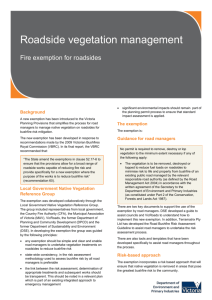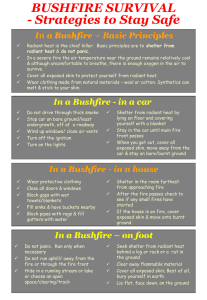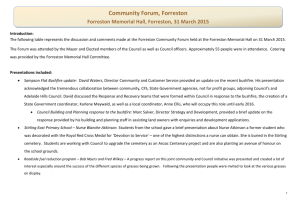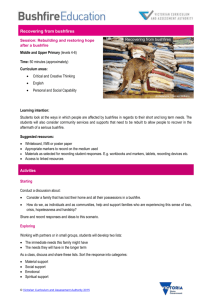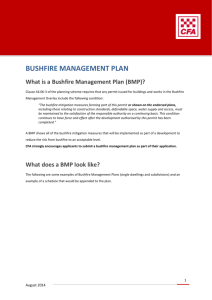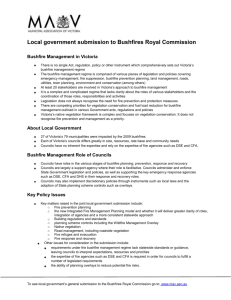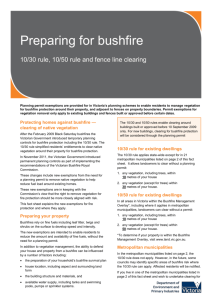Roadside vegetation management for bushfire mitigation purposes
advertisement
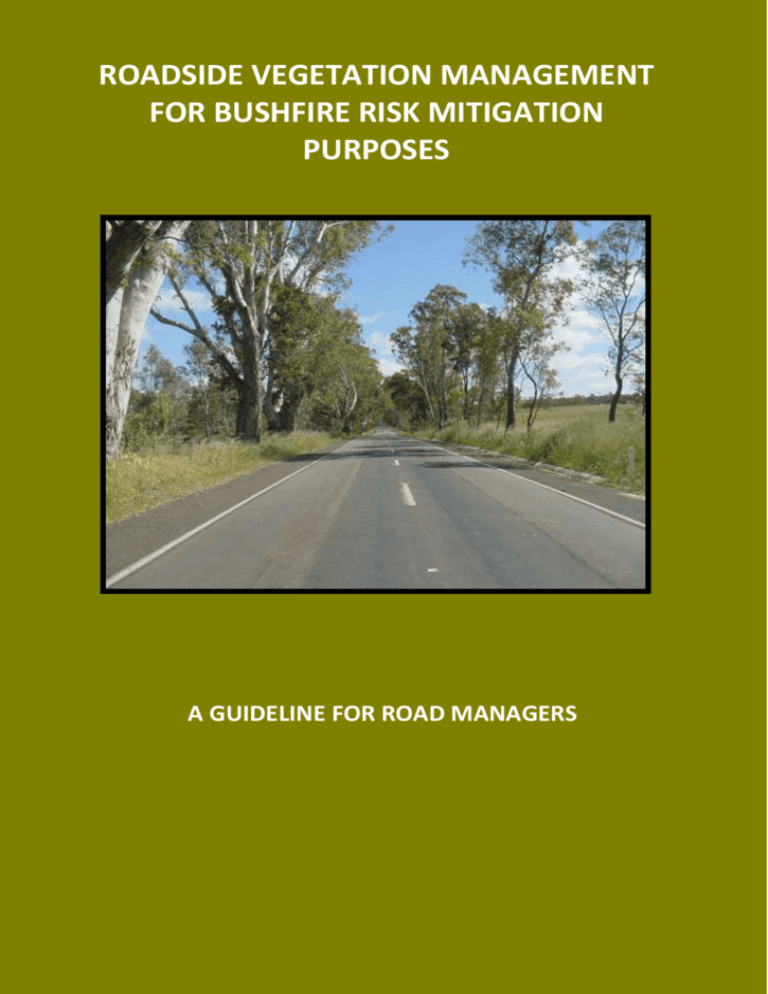
ROADSIDE VEGETATION MANAGEMENT FOR BUSHFIRE RISK MITIGATION PURPOSES A GUIDELINE FOR ROAD MANAGERS ROADSIDE VEGETATION MANAGEMENT FOR BUSHFIRE RISK MITIGATION PURPOSES Published by the Victorian Government Department of Environment and Primary Industries Melbourne, February 2012 © The State of Victoria Department of Environment and Primary Industries 2012 This publication is copyright. No part may be reproduced by any process except in accordance with the provisions of the Copyright Act 1968. Authorised by the Victorian Government 8 Nicholson Street, East Melbourne ISBN 978-1-74287-461-6 (online) For more information contact the DEPI Customer Service Centre 136 186 Disclaimer This publication may be of assistance to you but the State of Victoria and its employees do not guarantee that the publication is without flaw of any kind or is wholly appropriate for your particular purposes and therefore disclaims all liability for any error, loss or other consequence which may arise from you relying on any information in this publication. Accessibility If you would like to receive this publication in an accessible format, such as large print or audio, please telephone 136 186, or email customer.service@dse.vic.gov.au Deaf, hearing impaired or speech impaired? Call us via the National Relay Service on 133 677 or visit www.relayservice.com.au This document is also available in PDF format on the internet at www.depi.vic.gov.au ROADSIDE VEGETATION MANAGEMENT FOR BUSHFIRE RISK MITIGATION PURPOSES Table of Contents 1. INTRODUCTION .................................................................................................................... 1 Purpose .......................................................................................................................................... 1 Principles underpinning the Roadside Works for Bushfire Purposes exemption ......................... 1 2. THE EXEMPTION ................................................................................................................... 2 Roadside works for bushfire purposes .......................................................................................... 2 3. THE AGREEMENT .................................................................................................................. 2 4. RISK ASSESSMENT PROCESS ................................................................................................. 3 Fire Management objectives for bushfire management on roads ............................................... 3 5. TREATMENT SELECTION PROCESS ......................................................................................... 4 Assessment of fire treatment options ........................................................................................... 4 Identifying environmental, cultural and heritage values .............................................................. 5 6. ROADSIDE VEGETATION TREATMENTS COVERED BY EXEMPTION .......................................... 5 Exempt vegetation treatments...................................................................................................... 5 Vegetation treatments requiring a planning permit ..................................................................... 5 7. ENDORSEMENT OF THE WORKS PLAN................................................................................... 5 Municipal Endorsement ................................................................................................................ 5 DEPI Agreement............................................................................................................................. 6 8. IMPLEMENTATION ............................................................................................................... 6 No data collection requirements for exempt vegetation treatments .......................................... 6 Offsets ............................................................................................................................................ 6 Consequence for breach of exemption ......................................................................................... 6 9. REMOVAL OF PROTECTED FLORA UNDER THE FLORA AND FAUNA GUARANTEE ACT 1988 ..... 6 Issuing of licences under the FFG Act ............................................................................................ 6 10. ENVIRONMENT PROTECTION AND BIODIVERSITY CONSERVATION ACT 1999 ....................... 8 Overview of application of the EPBC Act to roadside bushfire risk mitigation activities.............. 8 What activities are exempt from EPBC Act approval? .................................................................. 8 Significant impact test ................................................................................................................... 8 Bushfire risk mitigation activities that may not have a significant impact ................................... 9 Bushfire risk mitigation activities likely to have a significant impact ............................................ 9 Appendix 1 –Flow Chart: Operation of Agreement .................................................................. 10 Appendix 2 - Interim VicRoads Road Bushfire Risk Assessment Guideline ............................... 11 Appendix 3 – Work Plan Template.......................................................................................... 12 Appendix 4 –Online Resources ...................................................... Error! Bookmark not defined. Appendix 5 – Template for information to accompany work plan ........................................... 16 ROADSIDE VEGETATION MANAGEMENT FOR BUSHFIRE RISK MITIGATION PURPOSES Road1 R O A D S I D E V E G E T A T I O N M A N A G E M E N T F O R BUSHFIRE RISK MITIGATION PURPOSES 1. INTRODUCTION Purpose The purpose of this guideline is to assist VicRoads and local councils to determine if works involving the removal of native vegetation for bushfire mitigation are exempt from planning scheme requirements under clause 58.02 of the Victoria Planning Provisions (Roadside Works for Bushfire Purposes). The guideline is also designed to assist road mangers to work though a risk assessment process as required by the new exemption. The Roadside Works for Bushfire Purposes exemption requires an Agreement between the responsible road authority and the Secretary of the Department of Environment and Primary Industries (DEPI). The overriding objective of this exemption is to protect human life (clause 13.05 Bushfire). The exemption simplifies and clarifies the process that responsible road authorities must undertake to reduce the threat of bushfires. The Country Fire Authority Act 1958 (section 43) establishes that it is the duty of every council and public authority in the country area of Victoria to take all practicable steps to prevent the occurrence of fires on and minimise the danger of fire spread on and from land and roads under their management and/or ownership. Under the Road Management Act 2004, VicRoads is responsible for freeways and arterial roads, while councils are responsible for local roads and some arterial roads within their municipality. Principles underpinning the Roadside Works for Bushfire Purposes exemption The development of the new exemption has been guided by the Local Government Native Vegetation Reference Group established by the Municipal Association of Victoria and DEPI, with representatives from local councils, the Country Fire Authority, VicRoads and the Department of Planning and Community Development. The exemption and guideline aim to: i. Simplify the task of road authorities undertaking vegetation treatments to reduce bushfire risk on roadsides. ii. Enable the development and promote the use of a formalised risk assessment methodology for assessing bushfire risk on roadsides. iii. Require vegetation treatments for high bushfire risk roads to be identified in a relevant plan endorsed by the municipal fire planning processes. iv. Retain a permit requirement to ensure that an appropriate process occurs for treatments proposing significant environmental impact. 1 Road2 R O A D S I D E V E G E T A T I O N M A N A G E M E N T F O R BUSHFIRE RISK MITIGATION PURPOSES 2. THE EXEMPTION Roadside works for bushfire purposes The new exemption is based on recommendations made by the Victorian Bushfires Royal Commission (VBRC) in its Final Report (2009). The VBRC recommended that the Victoria Planning Provisions be amended to enable a broad range of fire mitigation works to be implemented and a new exemption be introduced for the purpose of reducing bushfire risk. The VBRC also recommended that State and Commonwealth Governments provide clear guidance to councils to implement their bushfire mitigation responsibilities. The new exemption introduced under Clause 52.17 of all planning schemes is provided below: 52.17 FIRE PROTECTION The Vegetation is to be removed, destroyed or lopped to reduce fuel loads on roadsides to minimise the risk to life and property from bushfire on an existing public road managed by the relevant responsible road authority (as defined by the Road Management Act 2004) in accordance with the written agreement of the Secretary of the Department of Environment and Primary Industries (as constituted under part 2 of the Conservation, Forests and Lands Act 1987). 3. THE AGREEMENT The exemption is subject to an Agreement between the Secretary of DEPI and the relevant road authority. Details of the Agreement and the process that it underpins are provided below. It is recommended that the process will be integrated with regional and municipal fire planning. The Agreement requires that: A risk assessment is conducted by the road authority under the Interim VicRoads Road Bushfire Risk Assessment Guideline (TerraMatrix 2011) or an equivalent1 bushfire risk assessment, to identify priority roads for fire mitigation treatments. A treatment selection process is conducted to determine the appropriate risk mitigation treatments according to the Assessment Guideline or an equivalent selection process, including any required vegetation treatments. This process will require input from a number of agencies. The required vegetation treatments for high bushfire risk roads be contained or referenced in a relevant plan such as the Regional Strategic Fire Management Plan or Municipal Fire Management Plan. Only vegetation treatments covered by the exemption be undertaken. Note that vegetation treatments likely to have ‘significant environmental impacts’ require a planning permit. A works plan is provided that describes the location of the works to be undertaken, the objective that it is being managed for and the type of work proposed. A flow chart of the operation of the Agreement is provided as Appendix 1. 1 Should be discussed with DSE before completing a works plan. 2 Road3 R O A D S I D E V E G E T A T I O N M A N A G E M E N T F O R BUSHFIRE RISK MITIGATION PURPOSES 4. RISK ASSESSMENT PROCESS As outlined above, the use of the Agreement requires the completion of a risk assessment process. To assist road managers in undertaking this, the Interim VicRoads Road Bushfire Risk Assessment Guideline (Appendix 2) has been developed by VicRoads in association with the MAV, CFA and DEPI. The risk assessment guidelines assist VicRoads and local councils to identify high bushfire risk roads for treatment. Fire Management objectives for bushfire management on roads The Assessment Guideline is based upon the Roadside Fire Management Guidelines (CFA, 2001). It sets out four fire management objectives for bushfire management on roads: Objective 1: Prevent fires on roadsides Objective 2: Contain roadside fires Objective 3: Manage safety of road users Objective 4: Provide control lines 3 Road4 R O A D S I D E V E G E T A T I O N M A N A G E M E N T F O R BUSHFIRE RISK MITIGATION PURPOSES 5. TREATMENT SELECTION PROCESS Following the risk assessment process road managers should determine which fire risk mitigation treatments will provide the most benefit to community safety while having regard to other potential impacts such as amenity and the environment. Assessment of fire treatment options The treatment selection process should be consultative and requires the establishment of a multi-agency group to assess high priority roads and determine the appropriate fire mitigation treatments, including any required vegetation treatments. The multi-agency group should include representatives from the road authority, a Municipal Fire Prevention Officer, a Council Environmental Officer, a CFA Vegetation Management Officer, a DEPI Biodiversity Officer, a DEPI Fire Prevention Planner and/or an Operational Officer from the relevant fire services. The group should be led by the relevant road authority. It is important that the treatment selection process resolves any issues (environmental or cultural) before detailing works in the plan. It is recommended that road managers undertake the due diligence check for requirements under the Flora and Fauna Guarantee Act 1998 during the treatment selection process (see section 9 below) to assist in resolving any issues early in the process. This process will assist responsible authorities to make informed decisions on what treatment options are the most appropriate for the risks identified. The treatment selection process may include, but is not limited to the following: Roadside vegetation treatments (including fuel reduction burning) covered by the exemption or more extensive treatments requiring a planning permit. Traffic and emergency management plans for ‘leave early’ and evacuation options, including community education about evacuation routes to Neighbourhood Safer Place (NSPs) or other approved shelter options. Land use, settlement and landscape scale planning under regional and municipal fire planning processes. Community education about fire preparedness and ‘leave early’ options. Other strategies and responses contained in fire service operation plans, as well as improved fire services training. Environmental implications of treatment options, this may limit some options. Once the treatments have been established for each high bushfire risk road they need to be prioritised and works budgeted for. A works plan reflecting the works to be done needs to be developed and provided to the Regional (VicRoads) or Municipal Fire Management Planning Committees (municipalities) for inclusion or reference in the appropriate plans. The works plan will include: The location/s of works that will be completed. The roadside management objective/s that are being managed for. The type of treatment being carried out. This plan will be submitted to DEPI for approval. A template for a works plan has been provided at Appendix 3. 4 Road5 R O A D S I D E V E G E T A T I O N M A N A G E M E N T F O R BUSHFIRE RISK MITIGATION PURPOSES Identifying environmental, cultural and heritage values Subject to the overriding priority to be given to the protection of human life (clause 13.05 Bushfire), vegetation treatments should be selected with regard to relevant environmental, cultural, heritage and amenity values. There are a range of online resources available to assist decision-makers to determine important values. DEPI recognises that interpreting all of the information available may require some assistance. Therefore road managers are encouraged to contact their regional DEPI office for assistance with identifying relevant environmental values and the Department of Planning and Community Development for cultural and heritage values. 6. ROADSIDE VEGETATION TREATMENTS COVERED BY EXEMPTION Exempt vegetation treatments The Agreement authorises a range of vegetation treatments to be undertaken without the requirement for a planning permit. The vegetation treatments available under this exemption include the following: Removal of fallen trees and branches within the road reserve. Removal of fine fuels such as grasses, understorey shrubs and leaf litter within the road reserve, including their physical removal, fuel reduction burning, edge trimming and slashing, and selective weed control. Removal of hazardous trees and tree limbs that are dead, diseased, defective and have the potential to fall onto and block the road as a result of high winds before or during a bushfire. Removal of vegetation associated with routine maintenance of existing bushfire risk mitigation works such as established fire breaks, control lines and access tracks. Vegetation treatments requiring a planning permit Bushfire risk mitigation works that are likely to have a significant environmental impact on the road reserve will require a planning permit. Activities or works likely to have a significant environmental impact on the road reserve include the removal of all trees within the fall line of a road through direct removal or the broad-scale removal of grasslands using chemicals, grading or ploughing. It is recommended that road authorities nominate an officer with experience in environmental and/or vegetation management to determine and record whether the required vegetation treatments are exempt or may have a significant environmental impact on the road reserve. If the officer considers the implementation of the required vegetation treatments will likely have a significant environmental impact, then the officer should advise the road authority that a planning permit is required. 7. ENDORSEMENT OF THE WORKS PLAN Municipal Endorsement It is critical that the treatments contained in the works plan are endorsed by committees responsible for fire and emergency management prior to submitting to DEPI. It is recommended that the plan is endorsed by the Municipal Fire Management Planning Committee before being provided to the Municipal Emergency Management Planning Committee for comment/support. Following the required public consultation period , if required, the plan should be presented to Council for adoption. 5 Road6 R O A D S I D E V E G E T A T I O N M A N A G E M E N T F O R BUSHFIRE RISK MITIGATION PURPOSES DEPI Agreement The role of the Secretary of DEPI in the use of the exemption is to approve the works plan detailing removal or treatment of native vegetation only. Once submitted, DEPI will not be making an assessment of the adequacy of the plan as a bushfire mitigation tool. DEPI will notify road managers of compliance with the agreement (evidence of risk assessment, works plan etc) within 28 days of submission providing all information required is provided. Appendix 4 includes a suggested template for the information required when seeking endorsement of the work plan. 8. IMPLEMENTATION Once the plan has been agreed, road authorities are not required under the Agreement to consult with DEPI regarding the implementation of exempt vegetation treatments. However, they are encouraged to contact the regional office of DEPI if they need to clarify the terms of the Agreement and this guideline. No data collection requirements for exempt vegetation treatments Road authorities are not required to record the amount of native vegetation removed under the Agreement. Offsets Vegetation offsets are not required under the Agreement for native vegetation removed under the bushfire risk reduction exemption. If a permit is required, the requirement for native vegetation offsets remains. Consequence for breach of exemption It is important that road authorities implement the Roadside Works for Bushfire Purposes exemption responsibly. If a road authority applies the exemption incorrectly (.e.g. not part of an approved plan) and proceeds with such works without obtaining the required planning permit, the road authority may be liable for a penalty under section 127 of the Planning and Environment Act 1987 and/or other enforcement proceedings under that Act. In addition, the road authority may separately be liable for breaches of the Victorian Flora and Fauna Guarantee Act 1988 and the Commonwealth Environment Protection and Biodiversity Conservation Act 1999. For more information, see Sections 8 & 9 below. 9. REMOVAL OF PROTECTED FLORA UNDER THE FLORA AND FAUNA GUARANTEE ACT 1988 The Flora and Fauna Guarantee Act 1988 (FFG Act) is a Victorian Act administered by DEPI. The Act aims to protect native plant and animal species to ensure their survival and to preserve Victoria's biodiversity. The Act requires permission to remove protected flora. Issuing of licences under the FFG Act In order to assist road managers to undertake vegetation management for bushfire mitigation in an efficient manner, DEPI will issue a licence under the FFG Act to each road manager who enters into the Agreement. The licence will allow road managers to take protected flora, except for listed threatened taxa or communities when undertaking bushfire risk mitigation works under the planning permit exemption. 6 Road7 R O A D S I D E V E G E T A T I O N M A N A G E M E N T F O R BUSHFIRE RISK MITIGATION PURPOSES Licences will be issued once the road manager has entered into an agreement with the Secretary of DEPI (as per the planning permit exemption) and a plan has been submitted. The assessment of fire treatment options should also consider the requirements of the FFG Act at the same time. The licence will relate to fire mitigation activities only and will not cover other activities such as road construction. Licences will be issued for the period of time to which the plan relates to. In order to determine if the works are likely to impact on listed threatened taxa or communities, under the licence, road mangers will be required to undertake a desktop due diligence check. Where the check identifies listed threatened communities in the vicinity (500m) of the proposed works, further investigation will be required and in some cases a licence sought. The Desktop check should be undertaken using Biodiversity Interactive Maps (BIM). BIM can be accessed via the DEPI website http://www.depi.vic.gov.au/about-dse/interactive-maps. Figure 1 shows the process. More detailed information regarding the use of the licence and due diligence will be provided by DEPI with the licence at the time of issue. Desktop due diligence check Are there any records of threatened taxa listed under FFG Act in proximity (500m) of treatment area area? No Yes Site inspection by suitably qualified person Is the take of any threatened taxa listed under FFG Act required to implement the treatment? No Undertake treatment In accordance with terms of the pro forma licence – No further licence required. Yes Apply to DSE for licence to take threatened taxa listed under FFG Act.. In some cases a licence may not be issued. Licence issued Undertake treatment in accordance with specific terms of licence. Figure 1: desktop due diligence process required under the FFG Act licence. 7 Road8 R O A D S I D E V E G E T A T I O N M A N A G E M E N T F O R BUSHFIRE RISK MITIGATION PURPOSES 10. ENVIRONMENT PROTECTION AND BIODIVERSITY CONSERVATION ACT 1999 Overview of application of the Environment Protection and Biodiversity Conservation Act 1999 (EPBC Act) to roadside bushfire risk mitigation activities The Commonwealth Department of Department of Sustainability, Environment, Water, Population and Communities (DSEWPaC) has published a Bushfire management and national environmental law – fact sheet on the Environment Protection and Biodiversity Conservation Act 1999 (EPBC Act) and the role of DSEWPaC in regulating bushfire management activities carried out by public authorities Under the EPBC Act, actions that have, or are likely to have, a significant impact on a matter of national environmental significance require approval from the Commonwealth Government Minister for Sustainability, Environment, Water, Population and Communities (the Minister). The Minister will decide whether assessment and approval is required under the EPBC Act. The matters of national environmental significance (NES) with the potential to be impacted upon by roadside bushfire risk mitigation activities are: nationally listed threatened species and ecological communities. national heritage places. wetlands of international importance (Ramsar wetlands). migratory species protected under international agreements. Any action likely to have a significant impact on a matter of NES is required to be referred to the Commonwealth Environment Minister (through DSEWPaC) for a decision about whether assessment and approval is required under the Act. If road authorities think that bushfire risk mitigation activities might result in a significant impact then they must refer the proposal. If they are not certain, they can still refer the application and are encouraged to do so by DSEWPaC. What activities are exempt from EPBC Act approval? Activities that are exempt include: Activities approved or authorised under Commonwealth or Victorian laws before July 2000. Continued lawful land uses that were occurring before July 2000. This includes activities which have continued in the same location without enlargement, expansion or intensification, including activities done cyclically over long periods of time such as works to reduce the fire risk. The type of activities that fall within this category include: - maintaining access tracks and fire breaks. - maintaining existing fire infrastructure, services and utilities. - roadside weed control. - routine controlled burns of the type that have occurred in the past. Significant impact test Under the significant impact guidelines a “significant impact” is defined as an impact which is: Important, notable, or of consequence, having regard to its context or sensitivity. Whether or not an action is likely to have a significant impact depends upon the sensitivity, value, and quality of the environment which is impacted, and upon the intensity, duration, magnitude and geographic extent of the impacts. 8 Road9 R O A D S I D E V E G E T A T I O N M A N A G E M E N T F O R BUSHFIRE RISK MITIGATION PURPOSES As outlined in DSEWPaC’s fact sheet, in practice this means that activities which may result in the irreversible or permanent loss of nationally threatened communities or key habitats for threatened species should be referred for assessment and approval. Bushfire risk mitigation activities that may not have a significant impact Bushfire risk mitigation activities that are unlikely to require approval under the EPBC Act include: Routine fuel reduction burns. Routine maintenance of fence lines, access roads or tracks. Routine maintenance of existing fire breaks, fire infrastructure, services and utilities. Localised weed control by hand or small machinery. Bushfire risk mitigation activities likely to have a significant impact Bushfire risk mitigation activities may require Commonwealth approval if there is likely to be a significant impact on a nationally protected matter and no exemption applies. These activities may include but are not limited to: Constructing new fire breaks, asset protection zones, access roads or tracks on a significant scale, in habitat of nationally threatened species or areas that form part of a nationally threatened ecological community. One-off fuel reduction burns adjoining remnant forest that is important habitat for nationally threatened species or areas that form part of a nationally threatened ecological community. Proposed new burning regimes adjoining national heritage places or Ramsar wetlands. One-off fuel reduction burns in listed or high habitat value ecological communities that are not fire tolerant (for example, littoral rainforests and wet schlerophyll forests). Burning that may cause substantive indirect (downstream) damage to nationally protected matters as a result of post-fire erosion (for example, water quality within a Ramsar wetland). As discussed above, DEPI officers can assist responsible authorities to determine whether further guidance should be sought from DSEWPaC. 9 Appendix 1 –Flow Chart: Operation of Agreement Determine if planning permit required Enter agreement with DSE Agreement specifies: 1. Risk assessment 2. Treatment selection 3. Plan for exempt works 1. Undertake risk assessment In accordance with Interim Victorian Road Bushfire Risk Assessment Guideline 2. Undertake treatment selection Multi-agency group identifies appropriate treatments for roads Are works covered by agreement with DSE? 3. Submit plan for exempt works to DSE Yes No Determine if FFG licence required Are works within standard licence for roadside works? 10 Apply for planning permit No further requirements Yes No Apply for FFG licence DSE endorses plan within 28 days Appendix 2 - Interim VicRoads Road Bushfire Risk Assessment Guideline Please note this document will be made available separately. 11 Appendix 3 – Work Plan Template Objectives 1&2: Prevent fires on roadsides and contain roadside fires Additional approvals required? Flora and Planning Fauna Permit Road Longwarran Road, Big River Location description Between Small’s Road and Old River Lane Risk High Treatment Burning 12 Responsible authority CFA Did the due diligence check reveal impacts on threatened species? Is the treatment likely to have a significant environmental impact? No No Objective 3: Safety of road users (emergency access and egress roads) Additional approvals required? Flora and Planning Fauna Permit Road Shortwarran Road, Little Creek Tamaki Drive, Hamilton Birdland Road East, Little Creek Location description Between Old Road and Small River Street Between Great North Road and Silver Street Between Carl’s Road and Little Creek Highway Did the due diligence check reveal impacts on threatened species? Is the treatment likely to have a significant environmental impact? No No Priority Treatment Moderate Hazard tree removal Responsible authority Grassland Shire Council Moderate Hazard tree removal + Slashing High Removal of all trees within fall-line of road Grassland Shire Council No No Grassland Shire Council No Yes 13 Objective 4: Provide control lines (control lines and strategic fire breaks) Additional approvals required? Flora and Planning Fauna Permit Road Undertow Road Location description Between Forest Hill Road and Autumn Avenue Priority Treatment High Slashing 14 Responsible authority Grassland Shire Council Did the due diligence check reveal impacts on threatened species? Is the treatment likely to have a significant environmental impact? No No 15 Appendix 4 – Template for information to accompany work plan Roadside Vegetation Management for Bushfire Risk Mitigation Work Plan Clause 52.17-6 of the Victoria Planning Provisions (fire protection) exempts road authorities from the need to obtain a planning permit to remove, destroy, or lop native vegetation for bushfire risk mitigation works on roadsides. The exemption requires an Agreement between the responsible road authority and the Secretary of the Department of Environment and Primary Industries (DEPI). In order for the exemption to be accessed the Agreement requires the following: 1. A risk assessment conducted using the Interim Victorian Road Bushfire Risk Assessment Guideline or an equivalent bushfire risk assessment methodology. 2. A multi-agency treatment selection process in line with the Assessment Guideline or an equivalent selection process. 3. Vegetation treatments are included in a relevant plan for municipal endorsement. 4. Provision of a works plan to DEPI detailing vegetation treatments. This template is intended to guide the responsible road authority in preparation of a brief summary describing how these steps have been met and should be provided to DEPI along with a work plan for endorsement. Once endorsed, the vegetation management works documented in the work plan can be undertaken without the need for a planning permit for a minimum period of 12 months? The Agreement will be reviewed after 12 months at the request of either DEPI or road authorities. Further information about the exemption and requirements of the Agreement can be found in the Roadside Vegetation Management for bushfire risk mitigation purposes guideline on the DEPI website. Responsible Road Authority The responsible road authority for the roads identified in the attached work plan is: Primary contact Any queries in relation to the information contained in this document or the attached work plan should be directed to: 16 1. Risk Assessment A risk assessment should be conducted under the Interim Victorian Road Bushfire Risk Assessment Guideline (“the Assessment Guideline” - Appendix 2) or an equivalent bushfire risk assessment process, to identify priority roads for fire mitigation treatments. Is your organisation using the Victorian Fire Risk Register (VFFR) Roadside Bushfire Risk Assessment Mapping? Yes / No If no to above: Describe the risk assessment methodology used to identify high priority roads for bushfire risk mitigation works. (If using the VFFR Road Bushfire Risk Assessment Mapping there is no need to describe the methodology). 17 2. Treatment selection The Interim Victorian Road Bushfire Risk Assessment Guideline requires the establishment of a multi-agency group to assess high priority roads identified through the VFFR Risk Assessment mapping or equivalent process, to determine what fire mitigation treatments may be necessary, including any required vegetation treatments. It is recommended that road authorities nominate an officer with experience in environmental and/or vegetation management within their organisation to determine and record whether the required vegetation treatments are exempt under the Agreement or may have a significant environmental impact on the road reserve. It is also recommended that the due diligence check for requirements under the Flora and Fauna Guarantee Act 1998 were undertaken are undertaken at this stage. Which agencies were involved in the determination of vegetation treatments for bushfire mitigation purposes? Describe the treatment selection process including how environmental and cultural values have been identified and considered and whether a due diligence check for requirements under the Flora and Fauna Guarantee Act 1998 were undertaken. 3. Municipal endorsement 18 The Agreement requires that the treatments contained in the works plan are endorsed by committees responsible for fire and emergency management prior to submitting to DEPI. Provide a description of the endorsed plan in which the treatments are identified and the form of municipal endorsement. The works plan should be endorsed by the Municipal Fire Management Planning Committee, before being provided to the Municipal Emergency Management Planning Committee for comment/support. It is not a requirement, but it is preferred if the works plan is presented to Council for adoption. 4. Works plan Attach a work plan that outlines: the location of treatments that will be undertaken the type of treatment being carried out the roadside management objective/s that the treatments are intended to achieve If the work plan includes either of the following treatments, these treatments should be clearly identified in the work plan as being subject to further approval requirements: treatments that are likely to have a significant environmental impact are outside the scope of the agreement and will require a planning permit, and/or treatments that will require the take of threatened taxa or communities under the Flora and Fauna Guarantee Act 1988 (FFG Act) or species on a DEPI Threatened Species Advisory List which will require an application for a licence under the FFG Act Next steps Send the completed form and a work plan to the address below. Plans will be reviewed against the requirements of the Agreement within 28 days. Native Vegetation – Roadside Exemption Regulatory Strategy & Design Department of Environment and Primary Industries PO Box 500 East Melbourne VIC3002 19
